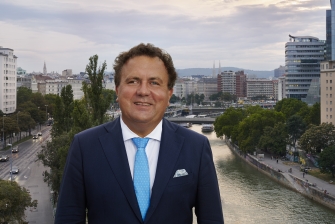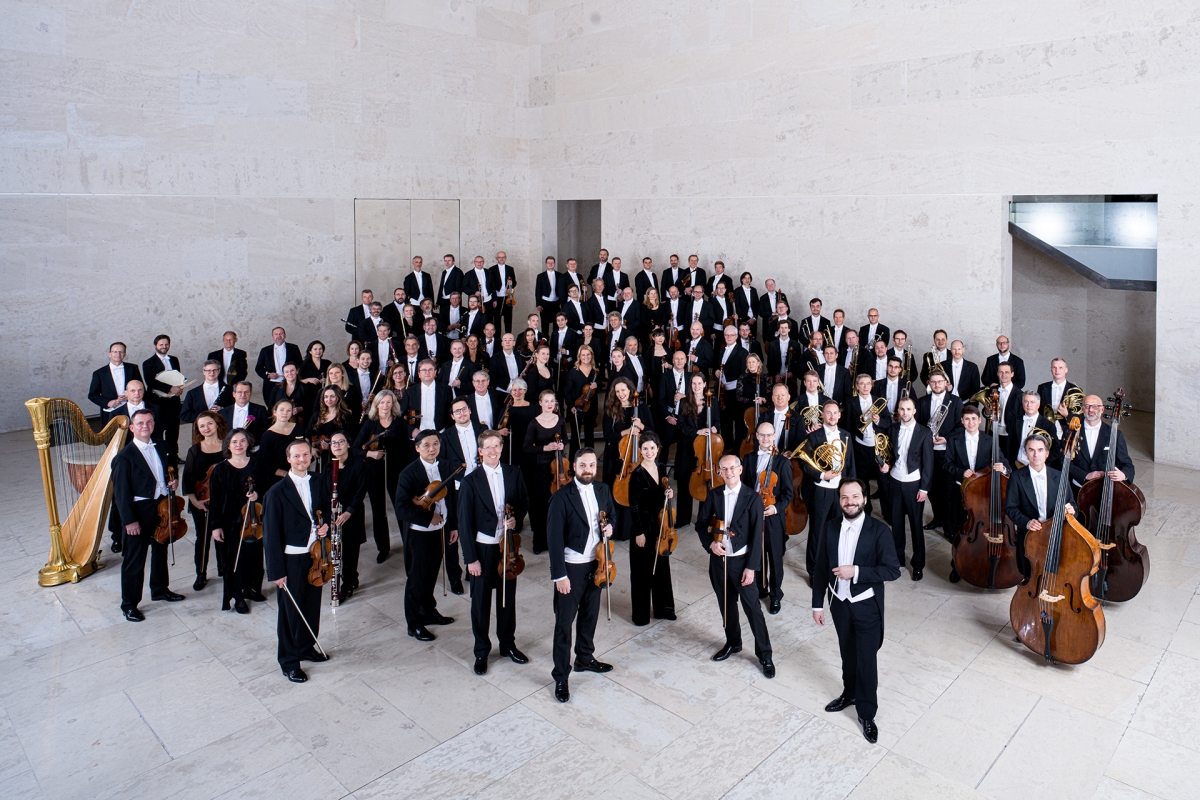Musical walk around Vienna
Musical walk around Vienna

When I first arrived in Vienna five years ago, as a stranger, excited about a new orchestra, I was faced with the challenge of familiarising myself with the city. Sure, „Vienna, City of Music“: homes to Mozart, Beethoven, Brahms, Schubert and Schumann, and the workplaces of Mahler and Schönberg. But how does one discover the soundtrack of a modern metropolis aside from the tourist clichés? How does one hear the sound of the city's orchestra, the Wiener Symphoniker?
There is probably no better way to explore a city than to let oneself be carried along by it. I live close to the Prater. In winter, there is a snowy, hushed atmosphere here, in summer the buzz of entertainment is pulsating – resounding voices in the Viennese heat. If you bike up the main alley, you are suddenly in an urban jungle, surrounded by the rustling of trees and the chirping birds. Vienna's soundtrack is limitless. The beating life in the Beisel neighbourhoods, on Schleifmühlgasse, the Servitenviertel, Praterstraße, or further out, in Margareten or Ottakring, utterly unique charming microcosms far from tourist routes. And then again the grand tranquillity of St Stephen's Cathedral, a silent landmark in the middle of the hustle and bustle of the city. A few metres further on, the clinking of beer bottles and the South American tango from a hi-fi on the Danube Canal. Subdued silence awaits us in the museums, an amazed hush in the Kunsthistorisches Museum, an anxious group of school children in the Wien Museum, and Hercules and Apollo lift the sky in the National Library without so much as a gasp.
The city’s sounding board
Vienna's soundtrack is versatile, endearing and at times gruff like the best dialogues of the „Alltagspoeten“ („all-day poets“), yearningly sensual with an awareness of the great history and jarring like a dance in the Bermuda Triangle (a Vienna quarter known for its many pubs and bars). The writer Karl Kraus said: „The streets of Vienna are paved with culture. The streets of other cities are paved with asphalt.“ To me, the Vienna sky is filled with sound, that of other cities with air.
I recognised quickly that Vienna is not only the city of music, Vienna itself is music. An orchestra here can not only be a broadcaster of tones, but is well advised to open its own ears. It is inspired by the sounds of its native city, its people, the soundtrack of Vienna - by music from the past and the sounds of today.
What a privilege it is that the city's orchestra can be at home in the most beautiful halls, in the Musikverein and the Wiener Konzerthaus, and regularly – for the opera – in the MusikTheater an der Wien. But it is also important to leave these beautiful „living rooms“ regularly to get a breath of the air out there, the air of the people, the air of life. And that’s exactly what we do again and again, always with curiosity. We celebrate the colourful summer in the Prater, the contemplative advent in St. Stephen’s Cathedral, we play in the pubs of the city, in the neighborhood football cages, in schools and Vienna’s sports facilities, and we engage in dialogue with the exhibitions in our museums by performing chamber music. The Wiener Symphoniker are the resonating body of this wonderful city.
One of my first visits, even before I took up my post as artistic director, was to the Wiener Symphoniker's archive. In a grey, fireproof filing cabinet in the Wiener Konzerthaus, I found the first „call“ for our orchestra. „The purpose of the Wiener Concert-Verein,“ it said, „is to organise symphony concerts at moderate admission prices, as well as popular orchestral concerts, at which classical works are to be performed in appropriate combination with works of a lighter nature, but of musical value.“ And then it read: „An orchestra which should also enable wider circles of the music-loving population of Vienna to enjoy symphonic music.“ It was clear to me that 125 years later, when the Wiener Symphoniker celebrate their anniversary, this arc should be completed again: an orchestra with something for all the people of the city. An orchestra that every Viennese should be able to experience at least once a year. An orchestra that embodies the sound of Vienna.
And so we began our walk towards the anniversary year. Our seasons were entitled „Puls der Stadt“ („Pulse of the City“), „Inmitten der Stadt“ („Amidst the City“) and „Echo der Stadt“ („Echo of the City“) – and everything culminates in the title of this anniversary season: „Orchester der Stadt“ („Orchestra of the City“). My visits to the Wiener Symphoniker’s archive have made me realise this: The orchestra should be approachable for everyone, but it is also a profoundly musical sounding body. Enthusiasm for music is most easily sparked by the highest quality. The Wiener Symphoniker have always combined breadth and excellence. And that is exactly what we wish to reflect in this very special anniversary season.
I think of the Wiener Symphoniker as a modern orchestra. An orchestra that is aware of the past and constantly translates the values of the past into a contemporary present. Just as the city of Vienna has changed over the last 125 years, so have the Wiener Symphoniker. Since its foundation, this orchestra has always been connected to the „now“, to being in the city, to the musical life of today – to the ears of the present. The Wiener Symphoniker have always embraced new developments, democratic and participatory elements and, above all, innovative compositions. Constant reinvention is part of our history.
Our journey to the anniversary season started four years ago with a major rebranding process in which the orchestra's musicians were actively involved. In terms of appearance, we orientated ourselves towards the turn of the century, when the Wiener Symphoniker premiered the works of great composers such as Arnold Schönberg. We commemorate the legendary premiere of the opulent Gurre-Lieder at the Musikverein this year. Schönberg himself conducted the world premiere of his symphonic poem „Pelleas and Melisande“, and Franz Schmidt’s „The Book with Seven Seals“ was also a trailblazing world premiere, which we commemorate in the anniversary season. Of course, we remain true to the tradition of new works: Marcus Nigsch will write a cello concerto for the Wiener Symphoniker, which will be given its first performance at the Musikverein. Our anniversary season is also a reminder that the Wiener Symphoniker are the orchestra of great symphonic works: Bruckner's 9th Symphony was premiered by the orchestra in a setting by Ferdinand Löwe, Gustav Mahler himself conducted the Austrian premiere of his Symphony No. 6 with the orchestra, Hans Swarowsky conducted the world premiere of Richard Strauss’ „Rosenkavalier“ Suite as part of the 950th anniversary celebrations of Austria. All these works are on the programme for the anniversary season, and our birthday concert on 30 October 2025 will also commemorate works premiered by the symphony orchestra with Maurice Ravel’s piano concerto for the left hand.
It goes without saying that the chief conductor of a modern orchestra is first and foremost responsible for its excellence. And I am delighted by the wonderful coincidence that our anniversary season is also Petr Popelka’s inaugural season. A conductor who, in my view, embodies the modern orchestra, who sees music as a collective adventure, but who is above all a musicologist and composer himself, who always places the works in the context of the world. In his debut concert, he introduces one of the most important composers for him: Béla Bartók.
Its conductors are of tremendous importance to the orchestra: we got to know Marie Jacquot at the „Living Room Concerts“ during the Corona pandemic, she is now our Principal Guest Conductor and has just been appointed Chief Conductor Designate of the WDR Symphony Orchestra. I am delighted that our former and much-loved chief conductors will be returning for this anniversary season: Philippe Jordan with Mahler’s Eighth and Fabio Luisi with Schmidt’s „The Book with Seven Seals“. After all, the line-up of our former chief conductors is also an expression of our music-making. Wilhelm Furtwängler, Hans Swarowsky, Herbert von Karajan, Wolfgang Sawallisch and Georges Prêtre have all shaped who we are today.
It is always especially exciting for an orchestra when it can pack the soundtrack of its city into its instrument cases and go on tour. I am delighted that we are travelling with a very thoughtfully selected programme for the anniversary season: María Dueñas will interpret Bruch’s violin concerto and Marie Jacquot will conduct a quite remarkable composition: Anton Bruckner’s Adagio from the Symphony No. 7 in an arrangement for 16 brass instruments, percussion and timpani by our very first principal conductor Ferdinand Löwe. This moving piece was played on 11 October 1896 in Vienna’s Karlskirche – at Anton Bruckner’s consecration, who had just died. On my walks through Vienna, I am often drawn to this wonderful church. And I envision how an ensemble of the Symphony Orchestra played the last farewell to one of the greatest composers here: so intimate, so moving, so beautiful. For me, these are true Vienna goosebumps moments. And I am convinced that the audience in the Elbphilharmonie in Hamburg, the Alte Oper Frankfurt or the Liederhalle in Stuttgart will all of a sudden breathe that unique Vienna air full of music when they hear this piece.
